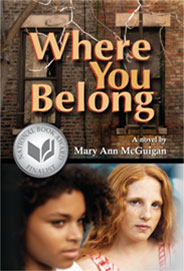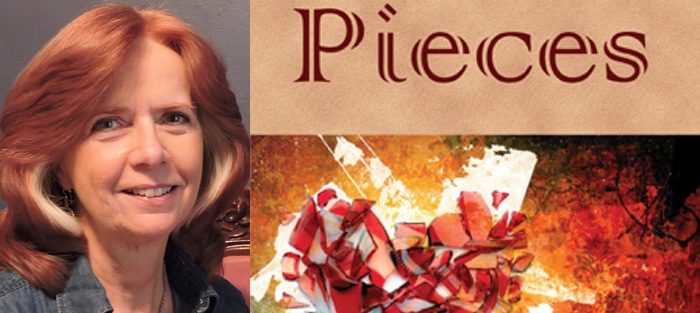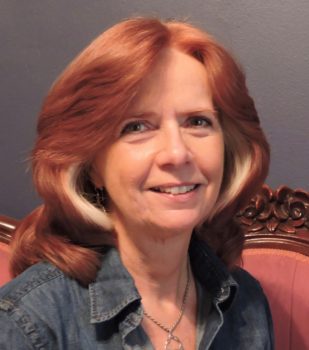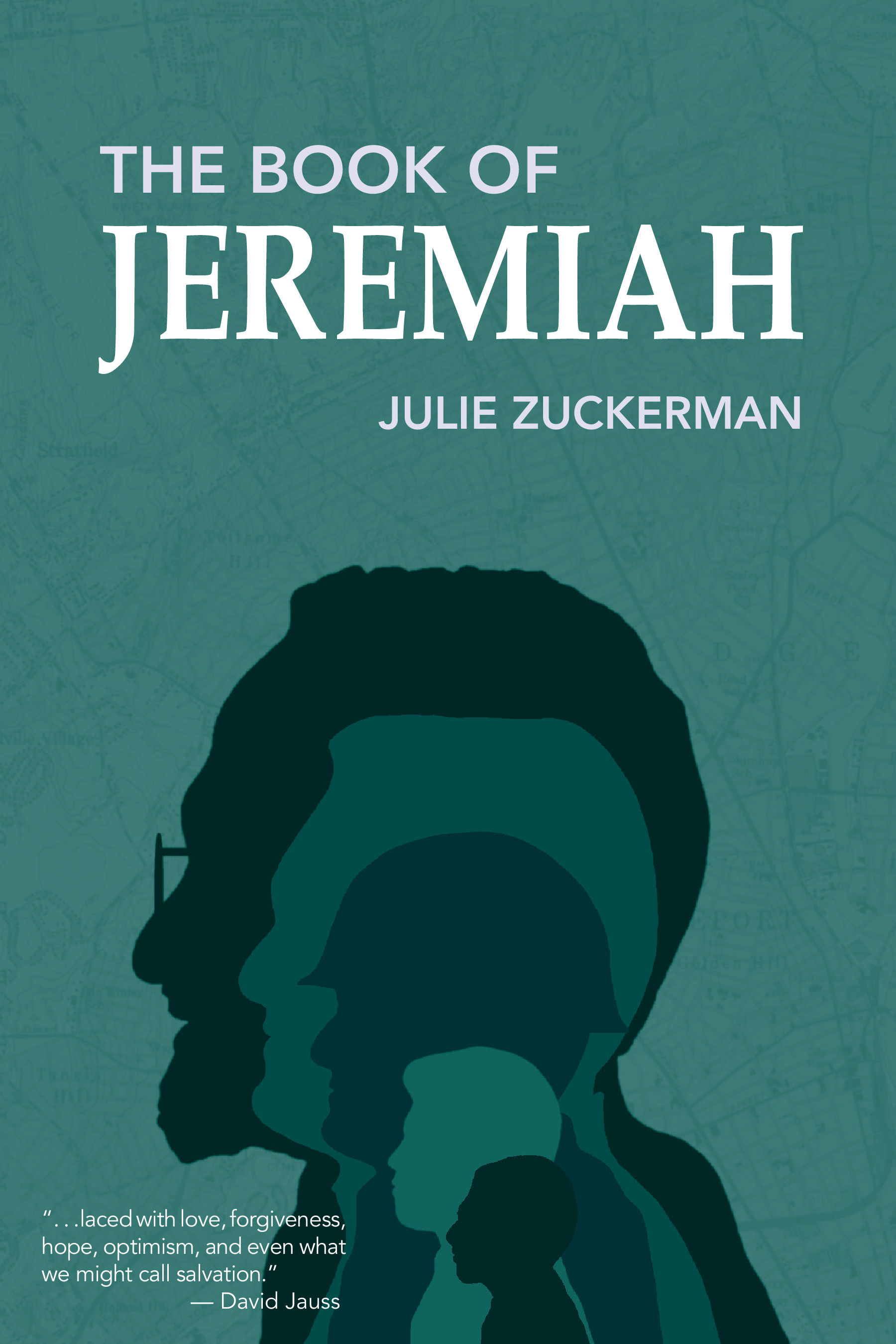I met Mary Ann McGuigan in 2015 at the Vermont College of Fine Arts post-graduate conference, when we participated in David Jauss’s short fiction workshop. I was introduced to her memorable characters through drafts she shared in that workshop and have since followed the progress of this project by workshopping stories with Mary Ann through an online writing community called Word Tango and by watching many of the individual stories from this book pop up in some of my favorite literary journals like North American Review, The Sun, r.kv.r.y quarterly, Main Street Rag, and Grist.
Published by Bottom Dog Press in December 2017, Pieces brings these stories together to narrate three generations of the Irish-American Donnegan family, troubled by alcoholism and domestic violence. She writes stories about the complicated interactions of family members and the ripple effect each family member’s decisions can cause. She does not shy away from difficult themes, and her realistic portrayals resonate long after the story is done. She captures the intricacies of our culture, exposes the secrets of domestic and cultural abuse, and challenges us to look at forgiveness in unique and lasting ways. There’s not a false note in her writing.
Mary Ann is an excellent critique partner, and she’s offered me valuable advice on the writing process, especially in regards to strength of voice and effectiveness of endings—you’ll find in her collection that she is a master of both. She is also the author of four young adult novels; Where You Belong (Atheneum, 1997) was a finalist for the National Book Award. Her short stories have twice been nominated for the Pushcart Prize.
Interview:
Jolene McIlwain: First, congratulations on the publication of Pieces, Mary Ann.
Mary Ann McGuigan: Thank you. I’m thrilled about it.
As a reader and a teacher, I’ve always been drawn to short story sequences and linked short story collections such as Olive Kitteridge, Love Medicine, The House on Mango Street, and Winesburg, Ohio—and now I plan to teach yours someday! Each of these collections is named/marketed differently. How did you decide on calling it a “composite novel”? And did that distinction have an effect on how you structured the stories? Also, was it difficult to collect and order the stories—did any not make the cut?
I did not find a publisher until the collection was finished, and I already saw the stories as related. It was the publisher who suggested the term “composite novel” and sent me information on it. The term had no effect on the structure or sequence of the stories: everything was already set. As I look back—remember these stories began being published in 1991—I see that I kept returning to the themes of alcoholism and its effect on relationships. The use of siblings from a large Irish Catholic family was comfortable to me because I come from one. I’ve written many stories that have nothing to do with these themes, but once I saw how strongly the related stories worked together, I realized the outliers could not be included.
 In these stories, one of the negative effects of alcoholism is certainly domestic violence. Many authors have taken on this subject—from Alice Walker’s The Color Purple to more the more recent Big Little Lies, by Liane Moriarty. Who were your influences in writing about domestic violence (or in writing in general)?
In these stories, one of the negative effects of alcoholism is certainly domestic violence. Many authors have taken on this subject—from Alice Walker’s The Color Purple to more the more recent Big Little Lies, by Liane Moriarty. Who were your influences in writing about domestic violence (or in writing in general)?
The book that had the strongest, most lasting effect on me was Toni Morrison’s The Bluest Eye. It made me believe I could tell “the truth” in a more compelling way by employing a young person’s point of view. The character Pecola in The Bluest Eye believes she’s ugly, because that’s the only feedback she’s ever received. This belief resonated for me, even in my early twenties, when I first read the book, because that was how I felt about myself. The ugliness was tied not so much to how I looked but to the shame I felt about the way I grew up: desperately poor in an alcoholic family with an abusive father. Seen from the eyes of a young person, Morrison reveals the adult world’s lies and rationalizations. Her writing made me realize that children were the perfect narrators. The adult world’s rationalizations don’t make sense to them because they just don’t add up. They contradict what they see with their own eyes. That’s the kind of raw reality I was striving for in “Song.” When Moira sits on her front steps amid the furniture as her family is evicted, she wants to be invisible. She’s desperate enough to return with her brother to her father’s apartment. When they get there, the neighbor’s contempt for them is evident. The shame it triggers in Moira is akin to the ugliness Pecola felt.
Your epigraph—
. . . there is time, still time,
for one who can groan
to sing
for one who can sing to be healed
—is part of Galway Kinnell’s poem “The Still Time.” How did you decide on that poem, specifically those lines, and which characters or stories did you have in mind as you chose this epigraph?
People who grow up in alcoholic families often don’t recognize how it has affected them until they’re older and their behavior has already done some damage to others and themselves. When I first heard this poem—though I have no idea what Kinnell intended it to be about—it brought to mind the strength of the human spirit to move on. The “groan” for me means giving voice to the pain, acknowledging that you’ve been hurt—overcoming denial is a huge step in recovery from alcoholic abuse, especially if the abuse is from parents. To sing, when you think about it, is a pretty silly thing to do, so for me in this poem it represents the move toward healing even when there’s no good reason to believe it will come.
In “A Wake for Maggie Fagan,” the family spontaneously sings a rousing, defiant song about death, even as they free their mom/sister from the cold restrictions of the funeral parlor so that they can wake her “properly” at home. In “Last Rites,” Conor doesn’t understand why he can’t move on, not understanding yet that it’s his own pain he must try to understand, not just why his father couldn’t respond to him. We could say he hasn’t managed to “groan.” The theme is present in just about all of the stories—that moment when the character sees, or can’t see, that his unwillingness to feel his own pain is what’s keeping him from moving on.
And yes, Liam and Moira sing when they visit their father in “Song.” Singing is finding connection, coping—sometimes coping with the domestic physical abuse that runs throughout the book.
Yes, in “Witness,” Maureen, the mother, sings to the children about Irish freedom fighters and attempts to distract their fear by getting them to sing together when they’re waiting for their father to come home, not knowing how drunk he’ll be.
You could probably make the case that every story in my collection contains abuse of one form or another. But the characters are not defeated by it. They find ways to go on, even if they wind up in more trouble. They’re like plants that seek the light even if they have to twist themselves out of shape to find it.
Abuse in families is a recurring theme in my YA novels as well. The main character in Where You Belong has an alcoholic father who’s physically abusive. The first several chapters of Where became the story “Song.” In my most recent YA novel, which my agent is having trouble selling, the parent’s alcoholism is tied to sexual abuse. As far as I can tell, sexual abuse of children remains a topic that YA editors don’t want to go near in any real way.
The #MeToo movement is bringing much-needed awareness to sexual abuse. But domestic physical abuse often remains hidden. Women without the resources to escape their situation are compelled to remain at risk. The abuse is sometimes kept secret—often by the women themselves. And even when it’s not hidden, it’s often routinely ignored by authorities.
The recent scandal with [staff secretary] Rob Porter in the White House is an example of how people go along with this. The Administration was willing to keep him on despite accusations that he’d abused his wives. That’s because as a society we don’t really want to know about domestic abuse. We’re willing to assume it’s not that bad. Chief of Staff John Kelly remembers a time “when women were sacred” in our country. There was never such a time.
“Holy Night” and “Home Front” were my introductions to your work a few years back and I fell in love with these stories. Although these two are still high up on the list, now I have some new favorites. Tomorrow it may be a different story at the top. I know it’s a hard question, but if you had to choose, which is your favorite story?
Thank you so much. My favorites are “Intercession” and “A Wake for Maggie Fagan.” I love people who are willing to break the rules if that’s what it takes to do the right thing, and Maureen is always ready to do that. One could argue that she’s not doing the right thing when she’s willing to pay for a teenager’s abortion, but I hope it’s clear that she loves the girl. In “Wake,” we see a family ready to upend what they know is wrong for their sister, to let her go without a proper goodbye. There are strong cultural reasons for their need to do this—which I try to articulate in the description of their grandmother’s wake—but it’s their need to stand by their sister that makes them take such extreme action.
I felt when I first read your stories that I wanted to know so much more about these people, this family, this place. What story were you writing when you decided this was likely going to be a collection?
By the time I wrote “Intercession,” published in 2011, I had a sense that these stories could work together.
In the first story, “Witness,” a young Moira strikes her father with the religious statue and thus begins the Catholic religion thread that runs throughout the book. I love how this statue image comes up again much later in “Intercession,” especially at the end when Moira’s mother, Maureen, is cleaning the broken statue. The book truly brings together the intricate pieces of family, marriage, religion, both the tangible and intangible.
Religion is front and center in “Asunder,” when Moira is questioned by Father Bertwin:
His demeanor is meant to convey balance and neutrality, but the collar does most of the work for him. Its associations for Moira are intractable—remnants of an Irish Catholic childhood in which idolatry trumped logic.
Can you speak a bit about this quote, and about what it was like to flesh out the effects of the Catholicism on these characters?
Maureen will not let what the Catholic Church does spoil the satisfaction she gets from contemplating the lives of the saints. Like so many Catholics—especially when it comes to birth control—she doesn’t care what the Church declares. Her contempt comes forcefully into focus when she does not discourage Charlene, her young helper, from getting an abortion and ultimately pays for it. Although one might argue that it was the sensible choice for the teenager, Maureen’s actions are in fact about how much she needs the girl. That her plan backfires is not meant as any kind of anti-abortion message. It’s simply about Maureen’s fear of change and the girl’s evolving view of her ability to love the child. Moira certainly expresses a similar contempt for the Church in “Asunder.” She’ll work within its ridiculous structures if she has to but only to stand up for her own idea of justice and prevent the annulment of her marriage.
I was raised Catholic, but I see the Church today as irrelevant. It plays no real role in the struggles of people suffering in the world. Although the Church’s teachings about Jesus Christ shaped the way I believe we should treat each other, I do not see the Church using its power and influence to do much good. In fact, in overlooking the devastation its priests have caused, it adds to the pain of innocent people. It has chosen to stand on the side of evil.
You mentioned that you wrote parts of this book over time, that you added the opening to “Witness” many years later. How long did you work on this project? And did your other projects affect/inform the process of writing this book?
Some of these stories were begun more than thirty years ago. My first YA novel (Cloud Dancer) was published in 1994 by Scribners. I was working full time, so each novel took a long while. But I would often take breaks to write short stories. I’ve never drawn a huge distinction between my YA fiction and my adult fiction. Cloud Dancer was written for adults. I submitted it as YA because children’s lit back then didn’t require an agent and my protagonist was young. “Song” was published in The Sun and later became the opening chapters of Where You Belong. In fact nearly all of my YA novels evolved from short stories for adults. The story “To Express How Much” was commissioned for a collection of stories by award-winning children’s authors. The story is intended for young people.
 How do you know when a short story could become a novel, or when a novel would work better as a short story? Has that ever happened?
How do you know when a short story could become a novel, or when a novel would work better as a short story? Has that ever happened?
When I’ve sought feedback on a story from other writers, they would often tell me that I should keep going with it, that they wanted to know more about that character. So I’d go back and explore and the rest would come. I’ve never had a novel idea that turned into a short story.
We met at the Vermont College of Fine Arts in David Jauss’s postgraduate workshop, where I read some excerpts of earlier drafts of these stories, and we’ve been in an online workshop together since. Do you attend many writing conferences, workshops, residencies? What does your writing life look like?
I never got an MFA. I just never had time. So I would attend as many writers’ conferences as I could and soak up information about good writing and about getting published. The postgrad conference at VCFA is by far the best I’ve ever attended and that’s mainly because of David Jauss. He reviewed all of the stories in the collection and helped me see problems I didn’t realize were there. He also convinced me the stories were good.
When we worked with Dave, I’m sure we both realized he was the master of teaching POV. So how did you decide who would “tell” each part? Without giving away any spoilers, did you try any stories in different POVs? For example, one story is in first person (“Song”). Did you try writing it in third?
Almost all the stories are told in third person, limited to the view of the main character. I did try to convert “Song” from first to third, but it lost all its urgency. I’m not sure why. I never change my mind about who the main character is. The voice usually comes to me in terms of what he’s feeling or something driving him. In “Last Rites,” it was Conor’s need to connect with his father. In “Asunder,” it’s initially Moira’s need to validate her marriage, but ultimately her need to protect her husband prevails.
In your opinion what makes a story good? What are your favorite short stories and why?
A good story gets me emotionally involved. If it doesn’t stir up feelings, I’m not motivated to read on. I admire craft and innovation, but I don’t truly care about that. Some examples are Lorrie Moore’s “Terrific Mother” (from Birds of America) and the stories of Colm Tóibín in Mothers and Sons, of George Saunders in Tenth of December, of Edna O’Brien in The Love Object, and of David Jauss in Glossolalia.
Of your work, David Jauss mentions in his blurb that you “write without melodrama about such radioactive subjects as alcoholism and physical and emotional abuse.” I can imagine some of these scenes were difficult to write, yet you do such an amazing job of moving the reader deeply into them. How do you approach writing about violence and abuse? Do your scenes start out as sketches that you fill in with revision or do you start with a full scene and pare back?
I start with a memory. And I often wind up extremely upset. From there, the characters take over, shaping events and relationships. But as I go back to polish, I know I have to let the reader discover the feelings on his own. I don’t need to supply anything more than a very clear picture of what’s happening. Fighting sentimentalism has been a struggle for me. Early on, it was the biggest problem in my stories.
How do you work? When do you find time to write? Do you write daily? Do you finish one project before starting the next?
Before I retired—I was a financial editor for many years—I wrote on commuter trains, on my lunch hour, on notepads at staff meetings, and at home into the wee hours. When my sons were little, I wrote while they napped, then at Little League games and whenever I had a few minutes. Now I write nearly every day. I’ve always worked on more than one thing at a time. While I’m working on a novel, I’ll step away and do something with a short story, often revising older versions.
Are there any other writers or storytellers in your family?
My family is filled with storytellers, as are most Irish families. But they tell them rather than write them. Most of the time, they don’t even need to embellish.
What is the message you wanted to put out there with this book? Why write it? Why write it now? How did it help you in understanding the human condition?
I don’t have any messages, really. But I guess I want my characters to show that the demons may hurt us, but they don’t have to defeat us. I know this isn’t always true. We don’t all survive. But even in the worst of it, when the chaos has left nothing behind, we see a kindness that’s still there—like in “Last Rites,” when Donnegan tells Conor this was never what he wanted for him. “It’s not all right,” Donnegan says. He can’t give Conor the Pollyanna answers he’s asking for, but he can give him that much.
As for why write, I have no choice. For as long as I can remember, writing has helped me want to keep going with life. It’s a way to do something that counts. By that I don’t mean something that counts in literary circles—although that can be lovely. I mean something that counts because it makes a reader feel understood, connected. I’ve received letters from young people who’ve told me this, and I’m so grateful.
You once served as one of the judges for the National Book Award for Young People’s Literature. What was that experience like?
Yes, two years after Where You Belong became a finalist, I served as a judge. I loved it. All these books began to arrive. And all I had to do was what I love best—read! But it took discipline, because I couldn’t choose them all. So many of them were truly excellent. My personal favorite was Laurie Halse Anderson’s Speak, although it wasn’t the winner.
And what is your next project?
My agent is trying to sell my YA novel, which features a character who’s been abused by her father. I’m also working on a novel (seems to be YA), set in Manhattan, about a boy who’s looking for his mother, who went missing when his younger sister was killed. In the opening chapter, he sees a homeless woman in the street, whom he’s convinced is his mother. I’m not sure where it will go yet.
Where can readers purchase Pieces?
The book is available on Amazon and at Barnes & Noble. My YA novels are available there as well. I’m also on Facebook and my website address is maryannmcguigan.com.




